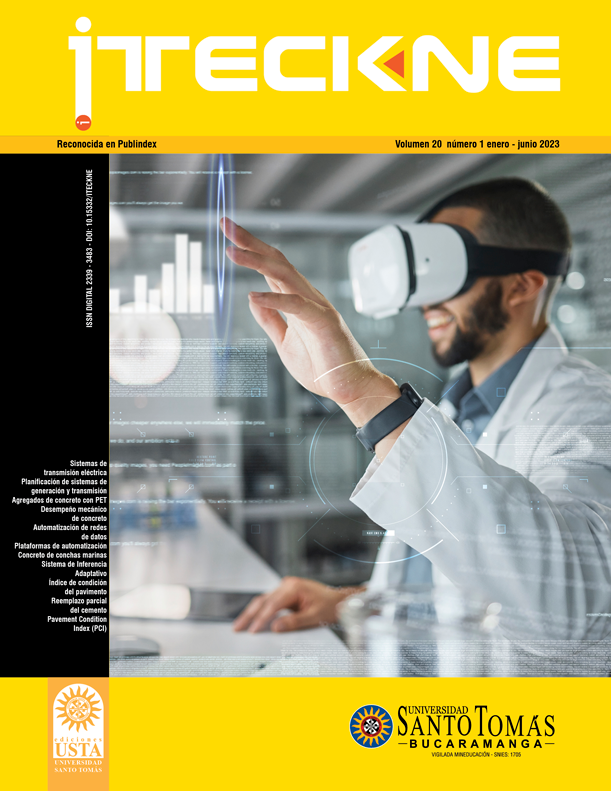Mechanical Performance of conventional concrete replacing coarse aggregate with polyethylene terephthalate
Abstract
In many countries, plastic waste is a polluting part of the environment, for this reason it is necessary to look for alternatives in which it can be reused massively, to significantly reduce it. In this research, the works associated with the subject were reviewed, the techniques used and the results obtained were analyzed, so that the necessary material was collected and, through laboratory tests, concrete cylinders were made with different substitutions of the aggregates coarse by plastic waste (PET); in order to compare the stress and costs of cellular concrete molds and those with plastic waste; and thus determine the viability of plastic aggregates in cellular concrete. In every one of the proportions of plastic waste used a decrease in weight and lower cost was observed, however, none managed to exceed the minimum resistance, compared with a conventional cylinder, when subjected to compression tests, being the size of the residues the biggest problem to obtain good results. To use plastic waste in the traditional concrete mixture, it is recommended to reduce the size of the particle to improve the cohesion of the materials, that is, crushed Terephthalate Polypropylene, which serves for the design of structural systems and obtains greater resistance, with this the pollution due to plastic waste would decrease significantly.
Downloads
References
[2] National Geographic, "5 cifras alarmantes sobre la contaminación por plásticos en el mundo," National Geographic en Español, 09 04 2019. [Online]. Available: https://www.ngenespanol.com/ecologia/5-cifras-contaminacion-por-plasticos-mundo/. [Accessed 12 2021].
[3] Superintendencia de residuos publicos domiciliarios , "Informe de disposición final de residuos sólidos - 2018," República de Colombia - Supersevicios, Bogotá, DC, 2019.
[4] Acoplásticos, "¿Qué es el PET?," Colombiaplast, 2021. [Online]. Available: https://www.acoplasticos.org/index.php/mnu-pre/opm-bus-pref/36-opc-fag-pre4. [Accessed 11 2021].
[5] Residuos profesional, "Reciclaje de pet para avanzar hacia una economía circular," Residuos profesional, 2020. [Online]. Available: https://www.residuosprofesional.com/reciclaje-pet-economia-circular/. [Accessed 11 2021].
[6] A. B. Acevedo Jaramillo and J. E. Posada Franco, "Polietileno tereftalato como reemplazo parcial del agregado fino en mezclas de concreto," Revista Ingenierías Universidad de Medellín, vol. 18, no. 34, pp. 45-56, 2019
[7] Departamento Administrativo Nacional de Estadística , "Estadísticas de Concreto," DANE, Colombia, 2022.
[8] J. González Sánchez, Construcción con botellas de plástico: análisis y mejora de elementos y sistemas constructivos estructurales., Madrid, España: Universidad Politécnica de Madrid, 2019.
[9] D. Ruiz Valencia, C. López Pérez, E. Cortes and A. Froese, "Nuevas alternativas en la construcción: botellas PET con relleno de tierra," Apuntes Revista de estudios sobre patrimonio cultural, vol. 25, no. 2, pp. 292-303, 2012.
[10] D. L. Tabaco Lombana and L. A. Silva Aparicio, Elaboración de una guía metodológica de autoconstrucción del usuario para viviendas temporales de un piso, utilizando materiales no convencionales, Bogotá: Universidad de la Salle, 2018.
[11] B. J. Hernández Hernández, Estudio comparativo de la resistencia a la compresión en mezclas de concreto elaboradas con materiales de reciclaje: Plástico y Llantas, Guatemala : Universidad de San Carlos de Guatemala, 2011.
[12] M. Sanabria, "Evaluación de las propiedades físico - mecánicas del concreto convencional reemplazando agregado grueso con polietileno de tereftalato en distintas proporciones," in Prácticas de Investigación Formativa: Experiencias en la aplicación de temáticas de ingeniería civil, Villavicencio, Colombia, Universidad Santo Tomás, 2021, pp. 410 - 426.
[13] V. H. Aliaga Cordova, Evaluación técnica de la mezcla de concreto con pet Reciclable, para la produccion de ladrillo de concreto Compuesto en la construccion, Lima, Peru: UNIVERSIDAD NACIONAL FEDERICO VILLARREAL, 2018.
[14] I. M. Reyes Montoya, Diseño de un concreto con fibras de Polietileno Tereftalato (pet) reciclado para la ejecución de losas en el asentamiento humano Amauta - Ate - Lima Este, Lima, Perú: UNIVERSIDAD RICARDO PALMA, 2019.
[15] Y. S. Torres Pérez and J. E. Lugo Mejía, caracterización del comportamiento mecánico del concreto simple con adición de fibras poliméricas recicladas pet, Bogotá, Colombia: Universidad Católica de Colombia, 2019.
[16] A. B. Acevedo Jaramillo and J. E. Posada Franco, "Polietileno tereftalato como reemplazo parcial del agregado fino en mezclas de concreto," Revista Ingenierías Universidad de Medellín, vol. 18, no. 34, pp. 45-56, 2019.
[17] A. Silvestre Gutiérrez , Análisis del concreto con tereftalato de polietileno (PET) como aditivo para aligerar elementos estructurales, Pereira: Universidad Libre, 2015.
[18] D. A. Torres and J. G. Bastidas, "Reinforced Concrete with Synthetic Fibers (PET+PP) for Rigid Pavement Structures," in Congreso Internacional de Innovación y Tendencias en Ingeniería (CONIITI), Bogotá, Colombia, 2018.
[19] C. Higuera Flórez, J. Cárdenas Pulido and A. Vargas Aguilar, "Evaluation of chloride penetration in cement mortars reinforced with different proportions of recycled PET fibers," in Congreso Internacional de Innovación y Tendencias en Ingeniería (CONIITI), Bogotá, Colombia, 2021.
[20] L. Marsiglio, S. Cheng, E. Falk, A. Fugh, K. Mulvaney, B. Slocum and D. Morris, "Comparing the Properties of Polyethylene Terephthalate (PET) Plastic Bricks to Conventional Concrete Masonry Units," in IEEE Global Humanitarian Technology Conference (GHTC), Seattle, WA, USA, 2020.
[21] J. James, A. Kirubhakaran, R. Balamurukan, V. Jawahar and S. Soorya, "Wetting-Drying Resistance of a Lime Stabilized Soil Amended with Steel Slag and Reinforced with Fibres," Revista ITECKNE, vol. 18, no. 1, pp. 7 - 17, 2021.
[22] J.A. Cardenas Gutierrez, J.L. Jácome Carrascal, M. Vergel Ortega, “Manejabilidad del concreto convencional mediante implementación de agregados alternativos,” Revista Boletin Redipe, vol. 10, no. 13, pp. 401 - 408, 2021.
[23] D. Sanchez de Guzman, “Tecnología del Concreto y del Mortero,” 5ª. Ed. Bogotá, Colombia. Bhandar Editores, Pontificia Universidad Javeriana. 2001
[24] A. L. Castro, R. P. T. Tiba y V. C.Pandolfelli, “Fibras de polipropileno esua influência no comportamento deconcretos expostos a altastemperaturas: revisão”, Revista Cerâmica, vol.57, pp. 22-31, 2011.
[25] A. Meza y S. Siddique, “Effect of aspectratio and dosage on the flexuralresponse of FRC with recycled fiber”,Constr. Build. Mater., vol. 213, pp. 286-291, 2019.
[26] Saucedo Rodríguez, J. A.., Atoche Zamora, J. J.., & Muñoz Pérez, S. P. Uso de los agregados PET en laelaboración del concreto: Revisión de la literatura. Revista Avances: Investigación En Ingeniería, vol. 18, no 2, pp. 1 - 10, 2021.



















